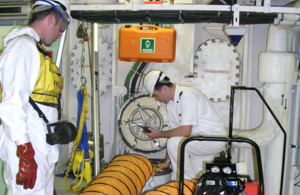Planning permission for the project at Castlehill has now been approved by Hull City Council and East Riding of Yorkshire Council and work is expected to start late spring.
A public consultation was launched in September 2020 on proposals for the ‘aquagreen’ – a versatile green space, south of the old Bransholme Dairy Farm, which will store excess water during a flood and then slowly release it back into the drainage system after the peak of the flood has passed.
Homes in North Carr and Sutton are currently at risk of flooding from water in the Holderness and Sutton Cross drains after heavy rain. The Holderness Drain is a man-made river channel. When it becomes full, water flows into Sutton Cross Drain, overwhelming the local drainage system and increasing the risk of flooding for homes in the area. This area narrowly avoided disaster in November 2019 when other parts of Hull were affected by flooding.
The ‘aquagreen’ is the second phase of the £28.5m Holderness Drain Flood Alleviation Scheme, and follows construction of the new East Hull Pumping Station.
The scheme has been made possible thanks to a close collaboration between a number of organisations:
Andrew Barron, Environment Agency flood risk advisor for Hull, said:
This is a really important step in the delivery of the Holderness Drain Flood Alleviation Scheme, which will reduce flood risk to hundreds of homes and businesses in the North Carr and Sutton areas. The scheme, which also includes a new pumping station, will contribute to making the Humber region more resilient to the effects of climate change.
Councillor Dean Kirk, Hull City Council’s portfolio holder for flood risk, said:
We are delighted that this important phase of the Flood Alleviation Scheme on Holderness Drain has received planning consent. The works at Castlehill will deliver many more benefits alongside the reduction in flood risk to homes and businesses.
These include job creation for local people through the materials and workforce supply chain in the construction phases, habitat creation, improved water quality, connecting communities with the heritage and nature of the site and amenity value.
Water is a key part of Hull’s heritage and this project will help enhance that link.
Councillor Chris Matthews, portfolio holder for environment and climate change at East Riding of Yorkshire Council, said:
I am pleased to see this important project going ahead to reduce the risk of flooding to hundreds of homes and businesses in this area.
Our areas have, unfortunately, seen many flooding events in the past few years but we hope that, by working together on schemes like this, we can mitigate that risk.
James Leeming, Senior Project Manager at National Highways, said:
It’s vital we keeping our roads flowing freely and protect the communities who live alongside them, so this decision is a significant advance in the fight against flooding in this area. We will continue to work closely with our partners along the A63 route to ensure the continued success of the Holderness Drain Flood Alleviation Scheme.
James Newman, Chair of the Hull and East Yorkshire LEP, said:
The Holderness Drain flood alleviation scheme has the potential to reduce the flood risk to hundreds of properties and large areas of land in Hull and the East Riding of Yorkshire.
We believe the Castlehill Scheme will not only improve the health and wellbeing of the local community, with the greater public access to woodland and grasslands, along with a network of paths, but it will also play an important role in the Government’s targets of working towards Net Zero.
This would not have been possible without this Legacy Project and I am delighted that we have been able to support this scheme.
This partnership scheme, led by the Environment Agency and supported by Hull City Council, East Riding of Yorkshire Council, National Highways and the Humber Local Enterprise Partnership’s Local Growth Fund Programme, will better protect around 1,000 properties and help to provide a long-term, more sustainable solution to the problem of flooding in this area. The Hull and East Yorkshire Local Enterprise Partnership secured £2.14 million towards the project through the Local Growth Fund as part of the Government’s commitment to the Northern Powerhouse.
The project is part of a record £5.2 billion investment by the Government in 2,000 new flood and coastal defences across the country between 2021 and 2027.
You can read a more detailed description of the changes to the plans in the full report, which can be downloaded from the Holderness Drain website:
Holderness Drain Flood Alleviation Scheme (FAS) – Information Page – Environment Agency – Citizen Space (environment-agency.gov.uk)
If residents have any questions they can email the project team at: HoldernessdrainFAS@environment-agency.gov.uk
To find out about flood risk in your area and to sign up to the Environment Agency’s free flood warning service, visit www.gov.uk/flood or call Floodline on 0345 988 1188.


